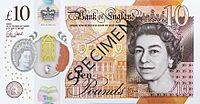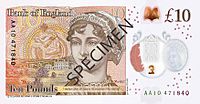Bank of England £10 note facts for kids
| (United Kingdom) | |
|---|---|
| Value | £10 sterling |
| Width | 132 mm |
| Height | 69 mm |
| Security features | See-through window with the Queen's portrait with a gold foil patch on the front of the note and silver on the back both in the shape of Winchester cathedral. raised dots, finely detailed bronze book shaped metallic image containing the letters 'J' and 'A', coloured border of a coloured quill shape which changes colour from orange to purple when the note is tilted, silver foil patch, micro-lettering, textured print, UV feature, hologram image in the shape of an open book which changes 'Ten' and 'Pounds'. |
| Paper type | Polymer |
| Years of printing | 1759–1943; 1964–1975; 1975-1992; 1992-2000; 2000-2016; 2017-present (current design) |
| Obverse | |
 |
|
| Design | Queen Elizabeth II |
| Design date | 14 September 2017 |
| Reverse | |
 |
|
| Design | Jane Austen |
| Design date | 14 September 2017 |
The Bank of England £10 note, often called a tenner, is a type of British money. It is one of the smaller value banknotes made by the Bank of England. The newest version, made of a special plastic called polymer, came out in 2017. It shows Queen Elizabeth II on the front and the famous writer Jane Austen on the back. Before this, the £10 note was made of cotton paper and featured Charles Darwin. This old note stopped being used on March 1, 2018.
Contents
History of the £10 Note
Early Banknotes: 1759 to 1943
The Bank of England first started making ten pound notes in 1759. This happened because there wasn't enough gold during the Seven Years' War. The very first notes were written by hand. They were given to people as needed. These notes only had writing on one side. They showed the person's name, the date, and the signature of the bank's cashier.
For a long time, you could exchange these notes for gold at the bank. This changed between 1797 and 1821. During the French Revolutionary Wars and the Napoleonic Wars, there was a shortage of gold. From 1853, printed notes replaced the handwritten ones. These new notes had a promise printed on them: "I promise to pay the bearer on demand the sum of ten pounds." This promise is still on Bank of England notes today.
Changes Over Time: 1931 to 2016
Britain stopped using the gold standard in 1931. This meant banknotes could no longer be exchanged for gold. The Bank of England stopped making £10 notes in 1943. They didn't come back until 1964. These new notes, called "Series C," were brown. They were the first £10 notes to show the Queen on the front. They also had a design on the back, which was a lion.
In 1975, the "Series C" notes were replaced by the "Series D." These new notes had a picture of Florence Nightingale on the back. The idea of showing important British people on the back continued. The "Series E" notes came out in 1992. They featured Charles Dickens. These notes were mostly orange-brown and had many colours. From "Series E" onwards, £10 notes included a special metal thread. This thread looks like a broken line, but it becomes a solid line when you hold the note up to the light.
A new version of the "Series E" £10 note was introduced in 2000. It showed Charles Darwin on the back. It also had pictures of his ship, the HMS Beagle, and different plants and animals. This note had several safety features. These included raised printing, a watermark, tiny writing, a hologram, and a number ten that only appeared under ultraviolet light.
The Polymer £10 Note: 2017 Onwards
In 2013, Mark Carney, who was the head of the Bank of England, announced a new £10 banknote. This new note would be made of polymer plastic instead of cotton paper. It would feature the writer Jane Austen. The note was officially released on September 14, 2017.
The decision to put Jane Austen on the note came after people asked for a woman to be on a banknote. This happened when it was announced that Elizabeth Fry, who was on the £5 note, would be replaced by Winston Churchill.
Like the £5 note with Churchill, the new £10 note is made from polymer. This makes it more durable and harder to fake. It shows several interesting things:
- A famous quote: "I declare after all there is no enjoyment like reading!" This line is from Jane Austen's book Pride and Prejudice.
- A portrait of Jane Austen: This picture was based on a sketch drawn by her sister, Cassandra Austen.
- An illustration of Elizabeth Bennet: This character is from Pride and Prejudice. The drawing shows her reading letters.
- An image of Godmersham Park: This was the home of Jane Austen's brother. She visited often, and it may have inspired her novels.
- Jane Austen's writing table: The background design is based on the special writing table she used at Chawton Cottage.
Winchester Cathedral, where Jane Austen is buried, is also shown on the note. It appears in gold foil on the front and silver on the back.
Designs of the £10 Note Series
The Bank of England has released different designs of the £10 note over the years. Each series has unique features and security elements.
| Note Series | First Issued | Last Issued | No Longer Legal Tender | Main Colour | Size | Main Design Features |
|---|---|---|---|---|---|---|
| White | 1759 | 1943 | April 16, 1945 | Monochrome | 211 × 133 mm | Printed on one side only. |
| Series C | February 21, 1964 | 1975 | May 31, 1979 | Brown | 150 × 93 mm | Front: Queen Elizabeth II; Back: Lion. First to have the Queen's portrait. |
| Series D | February 20, 1975 | 1992 | May 20, 1994 | Brown | 151 × 85 mm | Front: Queen Elizabeth II; Back: Florence Nightingale. Later notes had a "windowed" security thread. |
| Series E | April 29, 1992 | October 2000 | July 31, 2003 | Orange-brown | 142mm x 75mm | Front: Queen Elizabeth II; Back: Charles Dickens. |
| Series E (variant) | November 7, 2000 | 2016 | March 1, 2018 | Orange-brown | 142 × 75 mm | Front: Queen Elizabeth II; Back: Charles Darwin. |
| Series G (polymer) | September 14, 2017 | Present | Still Legal Tender | Orange | 132 × 69 mm | Front: Queen Elizabeth II; Back: Jane Austen. Made from polymer plastic. |
See also


